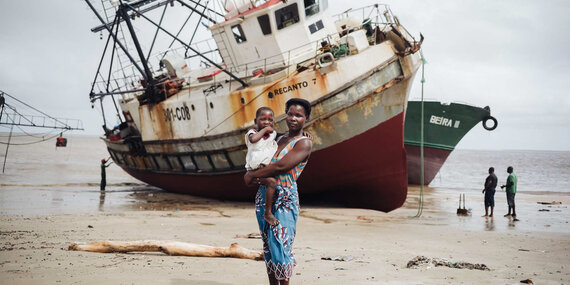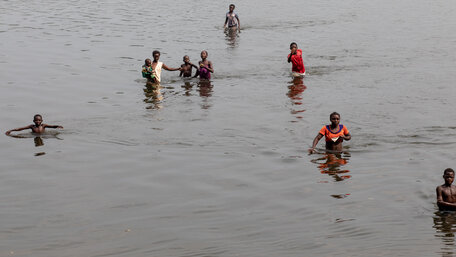Beira, Mozambique
This woman lives in a shanty town by Beira port. She explains her desperation: "My home was severely destroyed by the floods, and my husband hurt his leg. At first I thought it was just regular rain, until I realized this was a catastrophe. I was very frightened. Not everyone was as lucky; our neighbours lost a mother and son." Finnish Red Cross/Benjamin Suomela
In Eastern Africa, conflict and violence continued to force people to flee their homes in 2021, including around 9.6 million internally displaced people and 4.7 million refugees and asylum seekers. Every country in the region is either in conflict or neighbouring a country in conflict. In 2021, the crisis in Ethiopia drove millions of people from their homes, causing a spike in displacement in a region where the crises in Somalia, South Sudan and Sudan had already forced millions of people to flee in recent years. The Horn of Africa also remains a major route for mixed movements to and from the Arabian Peninsula and to Europe.
Humanitarian Response Plans
Grave violations against civilians continued to be committed in the region, including conflict-related sexual violence. The conflict in Ethiopia saw reports of widespread use of rape as a tactic of war, including in Tigray by Eritrean and Government forces and in Amhara by Tigrayan forces. In South Sudan, gender-based violence is deliberately used to humiliate women and girls; over 65 per cent of South Sudanese women have experienced sexual or physical violence—double the global average.
The region is experiencing a major food insecurity crisis, with more than 100,000 people in South Sudan and 400,000 people in Ethiopia facing Catastrophic food insecurity (IPC Phase 5), according to the latest IPC analysis. At least 33.8 million people are severely food insecure, and an estimated 12.8 million children are acutely malnourished, across the region. Despite significant progress, the severe desert locust upsurge continues to threaten livelihoods and food security in Somalia, Ethiopia and, to a lesser extent, Kenya. At the same time, multiple areas of the region have been impacted by back-to-back below-average rainy seasons and are likely to see drought conditions increase in the period ahead.
Southern and East Africa: Overview of appeals
Core health services, including immunization, sexual and reproductive health care and long-term and palliative care, have been jeopardized during COVID-19 and as a result of ongoing conflict in many areas. Meanwhile, COVID-19 containment measures have compounded the challenges faced by children, especially girls, whose risk of child marriage has increased by 25 per cent due to school closures. COVID-19 has also sparked a precipitous rise in gender-based violence.
Southern and East Africa: Evolution of requirements
In Southern Africa, communities are on the coal face of the global climate crisis. During the 2020-2021 cyclone season in the South-West Indian Ocean, tropical weather systems affected at least 681,000 people and brought heavy rainfall to Southern Africa, including in Botswana, Eswatini, Madagascar, Mozambique, South Africa and Zimbabwe, causing death, displacement, flooding, landslides and damage to homes, infrastructure and livelihoods.
In December 2020, at least 96,000 people across the region were affected by Tropical Storm Chalane, which hit Madagascar (139 people affected), Mozambique (73,254) and Zimbabwe (22,683). In January 2021, Tropical Cyclone Eloise, swept through large parts of the region, bringing heavy rainfall and strong winds, including in Madagascar, Mozambique and South Africa. Eloise killed at least 12 people (one in Madagascar and 11 in Mozambique) and affected more than 467,000 people across the region, including 2,800 in Madagascar, 441,690 in Mozambique, 3,200 in South Africa and 20,270 in Zimbabwe. Mozambique’s central provinces, which were still recovering from the devastation wrought by Cyclone Idai in 2019, were hardest-hit by Tropical Cyclone Eloise. The heavy rains also exacerbated the African Migratory Locust (AML) outbreak in Botswana, Namibia, Zambia and Zimbabwe.
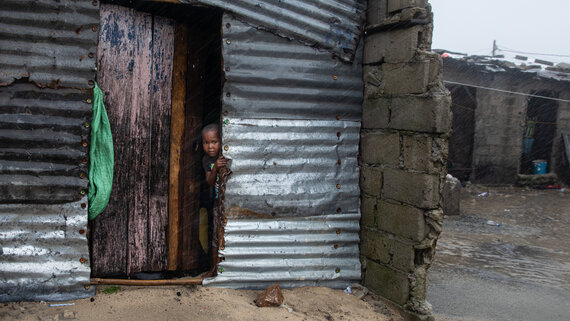
Beira, Mozambique
A child shelters from rising water in the Praia Nova neighbourhood in Beira, Mozambique. The country had to face Cyclone Eloise while still recovering from the devastation caused by category 4 Cyclone Idai in March 2019, which claimed hundreds of lives and affected 3 million people across Madagascar, Malawi, Mozambique and Zimbabwe.
UNICEF/Ricardo FrancoIn some parts of the region—especially southern Madagascar and southern Angola—erratic and uneven rainfall has caused severe drought. The Grand Sud of Madagascar is experiencing its most severe drought in more than 40 years, leaving an estimated 1.3 million people severely food insecure—more than double the number in the same period of 2020—of whom at least 28,000 are facing Catastrophic (IPC Phase 5) food insecurity, according to the Integrated Food Security Phase Classification (IPC) analysis. In a worst-case scenario, Ambovombe-Androy District will be at risk of famine from October, according to an IPC analysis carried out in June 2021. In Angola, hunger is on the rise as the country experiences its worst drought in decades, with below average rainfall in Cuanza Sul, Benguela, Huambo, Namibe and Huíla provinces driving rising needs in the western-southern part of the country.
COVID-19 has had major consequences for Southern Africa. South Africa has had the highest number of recorded COVID-19 cases and deaths on the African continent, while COVID-19 containment measures have caused protection concerns and hampered access to basic healthcare, including for sexual and reproductive health.
Meanwhile, the conflict in Mozambique continues to cause a large-scale humanitarian crisis, with potential regional ramifications. Despite the recent intervention by SADC and Rwandan forces, the situation is expected to remain highly volatile in the coming months, and more than 745,000 people remain displaced by insecurity and violence. At the same time, other countries in Southern Africa are facing challenging domestic situations, especially Eswatini, which has faced significant civil unrest since May 2020.
Projected situation in 2022 and beyond
In Eastern Africa, needs are likely to rise in 2022 due to conflict, political fragility and economic challenges. The conflict in Ethiopia is likely to have major repercussions, with displacement and needs expected to rise unless a negotiated settlement is realized. In Sudan, the situation is precarious following the military coup in October 2021, and needs were already increasing due to conflict, climatic events and the economic crisis. In Somalia, heightened political tensions and the continued military offensive against Al-Shabaab in central and southern areas, continue to drive displacement, while Kenya is approaching highly contested elections and the continued threat of Al-Shabaab. In South Sudan, despite the ongoing implementation of the 2018 Revitalized Agreement on the Resolution of the Conflict on the Republic of South Sudan (R-ARCSS), conflict continues to impact communities in multiple parts of the country.
At the same time, the climate crisis is expected to have devastating consequences for communities in Eastern Africa in the year ahead. Four countries in the Horn of Africa (Eritrea, Ethiopia, Somalia and Sudan) are among the most vulnerable 10 per cent to climate change, according to ND-GAIN. In South Sudan, historical floods—which have inundated large swathes of the country for the third time running—have impacted an estimated 623,000 people in 21 counties since May 2021, with the hardest-hit states including Jonglei, Unity and Northern Bahr el Ghazal. In some areas, the 2021 rains arrived even before the 2020 floods had fully receded. Elsewhere, in parts of Kenya, Ethiopia and Somalia, communities have already experienced two below-average rainy seasons and are likely to endure a third in the coming months, heightening the possibility of a dramatically deepening drought and a return to the levels of need seen during 2016 and 2017.
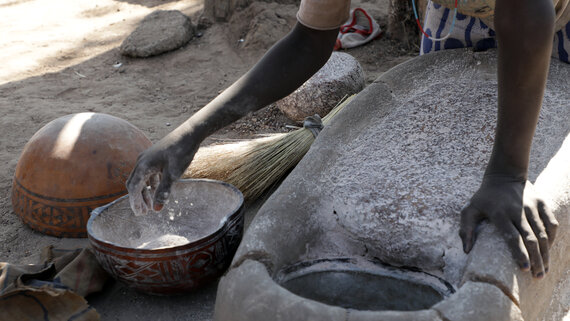
Jur River County, South Sudan
A young girl grinds flour from sorghum to make food for her family displaced by intercommunal conflict in South Sudan’s Jur River County.
OCHA/Anthony BurkeIn Southern Africa, the 2021-2022 cyclone season is expected to see the development of 8 to 12 weather systems (tropical storms and cyclones), of which 4 to 6 could become tropical cyclones. Recent years have highlighted the possibility of cyclones forming in the south-west Indian Ocean that are stronger, carry more rain, and take different paths than has historically been the case. Madagascar and Mozambique are at greatest risk for cyclonic activity, given their locations. However, as the 2020-2021 season proved, other countries may be impacted and, with a weak La Niña predicted to persist from December 2021 to February 2022, the risk of tropical storms and flash flooding is heightened, especially in parts of Mozambique, Madagascar, Zimbabwe, Eswatini and Malawi.
While above-average rainfall is predicted across much of the region—which should lead to favourable maize harvests in multiple countries—southern Madagascar and southern Angola are expected to continue to face drought. In both of these locations, there is a high probability of humanitarian needs increasing significantly as the countries enter the peak hunger gap from January to April in 2022, and potentially beyond, should the next harvest be below average or fail.
Meanwhile, humanitarian needs are likely to remain high in northern Mozambique, where the conflict situation is still volatile, despite the recapturing of territory by the Government and allied foreign forces in the second half of 2021. At the same time, political challenges are expected to persist in several countries in the region, especially in Eswatini, where people’s access to essential services has been hampered by civil unrest.
Further reading
Source: OCHA
Burundi
Analysis of the context, crisis and needs
In 2021, despite decrease in number of people in need, the vulnerabilities of the population in Burundi has increased compared to previous years due to the combined effects of recurring natural disasters, such as flooding caused by the rising waters of Lake Tanganyika and Rusizi River, frequent epidemic outbreaks, the socioeconomic impacts of COVID-19, as well as increasing refugee returns, which are putting pressure on host communities.
In April and May 2021, floods affected over 52,000 people, including 22,500 displaced people. This represents 82 per cent of all displacements in 2021 as of October. Between May and September 2021, over 33,000 people (50.4 per cent) of 65,000 people affected by floods received multisectoral emergency assistance.
The number of IDPs slightly decreased in 2021 (116,000 in August 2021 compared to 131,000 in August 2020, an 11 per cent decrease). However, protracted displacement and repeated shocks erode resilience and increase dependence on humanitarian aid where durable solutions are not provided. Over 80 per cent of internal displacement in Burundi is caused by climate-related disasters. The effects of climate hazards continue to impact agricultural production, while 90 per cent of the population relies on subsistence farming.
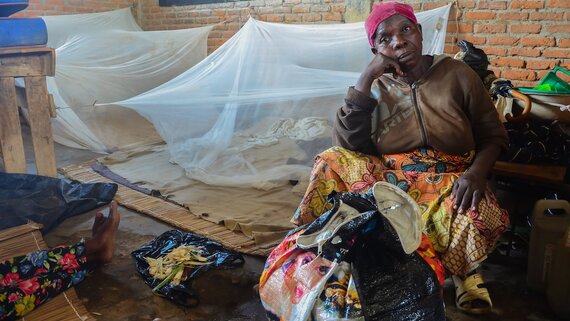
Bujumbura Rural Province, Burundi
A woman sleeps with her daughter and four of her grandchildren under a mosquito net. They sought shelter in the nearby school, which was already crowded with families sheltering after flooding displaced about 10,000 people last year. She said: “We’re cold at night. We lost everything; we lost all our blankets and clothes. The water rushed in quickly while we were asleep, so we grabbed the children and made our way to this school.
OCHA/Lauriane WolfeVoluntary returns of refugees increased in 2021, with 60,821 refugees repatriated between January and October 2021, compared to 26,868 in the same period in 2020 (a 126 per cent increase). This puts additional pressure on host communities, particularly in terms of access to food and basic services. In addition, the situation of over 83,000 refugees and asylum seekers remains precarious. Nearly 38 per cent of refugees live in urban areas where the economic situation is fragile. For refugees living in camps, there are few job opportunities, resulting in high dependency on humanitarian assistance.
The downward trend of malaria cases observed in 2020 (thanks to the mass distribution of mosquito nets and the fumigation of homes in 2019, and some good practices within communities) has reversed in 2021.There are 30 per cent more malaria cases in 2021 (as of October) than during the same period in 2020. Considering that 87 per cent of Burundians live with less than US$1.90 a day, vulnerable people affected by malaria outbreaks depends on emergency response.

Higiro, Burundi
Two Burundian returnees in Higiro.UNHCR is assisting the returns. It conducted assessments to ensure the decision to return is voluntary, free and informed, and that repatriation takes place in safety and dignity.
UNHCR/Georgina GoodwinDespite improvements in agricultural production confirmed by two successive satisfactory harvesting seasons in 2021, some areas remain at risk of food insecurity. According to the Integrated Food Security Phase Classification (IPC) data, despite improved food security conditions in parts of the country, over 12 per cent of the population (1.4 million people) is severely food insecure (IPC Phase 3 – Crisis).
Between January and June 2021, over 354,000 (33 per cent) of the 1.06 million people targeted in the Humanitarian Response Plan (HRP) 2021 received multisectoral humanitarian assistance. Only 25.7 per cent of the HRP was funded as of 26 October 2021 compared to 34.3 per cent at the same period in 2020. The low level of funding has hampered humanitarian partners’ efforts to meet the needs of the most vulnerable people. Based on the reporting to OCHA’s Financial Tracking Service, the most underfunded sectors include shelter and non-food items, WASH and protection.
Projected situation in 2022 and beyond
In 2022, about 1.8 million people will need humanitarian assistance, which is a 21 per cent decrease compared to 2021. Food assistance needs have decreased following relatively good harvests that have helped strengthen the population’s capacity to cope with future shocks. Nevertheless, the consequences of recurring natural disasters and epidemic outbreaks, including the socioeconomic impacts of COVID-19, are expected to continue to contribute to significant humanitarian needs in Burundi throughout 2022, especially in terms of food security.
According to weather forecasts, drier-than-usual conditions in late 2021 and early 2022, particularly in the eastern and northern parts of the country, risk impacting the first cropping season of 2022, the availability of seeds for future seasons and therefore food security in some areas. The 2022 rainy season is expected to induce new flooding, as the lake’s water levels are still high and soils in coastal areas in the western part of the country are saturated with water from previous floods. This may once again impact vulnerable populations in flood-prone areas. Despite efforts to strengthen disaster risk reduction capacity, Burundi’s preparedness for emergencies and crises is weak. The country cannot cope with severe shocks such as droughts, epidemics and floods.

Gatumba, Burundi
Lake Tanganyika’s rising waters caused flooding that hit the Gatumba area during the rainy season in April and May 2021. This mother of six had to improvise a temporary shelter for her family. She has owned their home since 1977, and this is the first time she has had to leave it. She explains: "It was very dangerous; we were up to our necks in water. I am looking for every way to get my children to school. I live off small businesses with DRC, but with the border closed, I do small jobs in the fields."
OCHA/Camille MarquisIn 2022, 70,000 Burundian refugees are expected to return to Burundi, compared to 143,000 in 2021. Overall, 178,000 returnees, including spontaneous returnees and former returnees experiencing acute vulnerability, will continue to need assistance in 2022. Additionally, 116,000 IDPs will continue to depend on aid for their survival and well-being. Due to the lack of durable solutions, humanitarian needs of IDPs and returnees from previous years will remain.
Malaria cases are expected to increase in 2022 if no prevention measures are implemented. This is most likely to affect the most vulnerable populations who have limited access to health care and prevention capacities.
Response priorities for 2022
Burundi’s 2022 HRP will target 947 thousand people out of an estimated 1.8 million people in need of humanitarian assistance, with $183 million required for the response. The response will prioritize the most vulnerable populations, particularly returnees, victims of natural disasters, including IDPs, and those affected by/at risk of epidemics, food insecurity and malnutrition. Of the 1.4 million people who are food insecure 508,000, will be targeted for food assistance in 2022.
Burundi HRP
The priority areas of intervention will include provinces classified at severity level 5 (Makamba, Rumonge and Ruyigi), severity level 4 (Bujumbura, Cankuzo, Karusi, Kirundo and Rutana) and severity level 3 (Bubanza, Cibitoke and Muyinga), as identified during the intersectoral severity analysis and endorsed during the Response Planning Workshop.
Further reading
Source: OCHA
Source: Humanitarian Insight
Source: Financial Tracking Service
Ethiopia
Analysis of the context, crisis and needs
A significant portion of Ethiopia’s population urgently needs humanitarian support, with armed conflict, climate shocks (including drought and flooding), disease outbreaks, a desert locust invasion and the continuing socioeconomic impacts of COVID-19 undermining the significant development gains made over recent years.
The impacts of frequent and extreme weather events continue to negatively affect access to food from cultivated crops, access to land for pasture, livestock production and market functionality. Several hundred thousand people are typically displaced each year due to floods, and on average approximately 3 million people experience crisis levels of food insecurity due to poor rains or drought conditions each year. Displacement caused by the intensification and expansion of the conflict in northern Ethiopia in addition to long-standing intercommunal tensions and regional border disputes are the main drivers of humanitarian needs. The displacement trend has increased over the last three years, rising from 3.2 million internally displaced persons (IDPs) recorded in 2018 to 4.2 million at the end of 2021.

Gijet, Ethiopia
A health worker evaluates a child during a malnutrition screening in Gijet, Tigray region. The crisis in northern Ethiopia has left millions of people in need of emergency assistance and protection. Access to communities is hindered by the limited availability of fuel, telecoms, supplies, shipments and cash to run humanitarian operations.
UNICEF/NesbittDisplaced people generally have limited access to nutritious food, protective shelter, safe water and sanitation facilities, as well as basic services to meet their basic needs. Displacement contributes to and exacerbates protection risks, including risks in relation to sexual and gender-based violence; family separation, including unaccompanied and separated children, or elderly persons or persons with disabilities who may be left behind during periods of displacement; housing; land and property issues; loss of civil documentation; and livelihoods concerns. In areas of displacement, elevated socioeconomic poverty further increases the risk of sexual and gender-based violence, particularly for women and girls. In situations of displacement, elderly persons and those living with disabilities may experience abandonment, neglect and unequal access to basic services, notably food and health care. Inability to access education directly impacts displaced children’s safety and well-being.
Projected situation in 2022
Climate shocks, conflict, insecurity and disease outbreaks coupled with a deteriorating economy will continue to exacerbate humanitarian needs in 2022 for 25.9 million people. Latest available reports of observed and projected short-term rainfall offer a pessimistic outlook. Seasonal forecasts published in September 2021 indicate high confidence that the deyr/hageya season (October to December) will see below-average rainfall in the country’s low-lying and southern parts. This would represent a third consecutive poor rainy season, increasing the risks of poor crop performance, the deterioration of livestock conditions and productivity, as well as water shortages for human and animal consumption. The far-reaching humanitarian impacts of armed conflict will continue to affect communities in 2022 across the north of the country and in several other hotspots. An inability to respond at the levels needed will result in further displacement, exacerbate living conditions for existing IDPs and others in vulnerable situations and increase protection risks, including those linked to negative coping mechanisms.
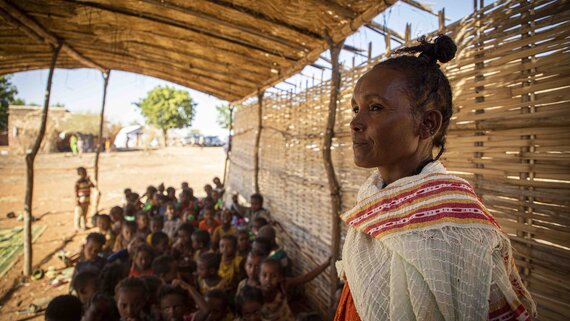
Al Qadarif, Sudan
This teacher is one of the Ethiopian refugees who volunteered to teach children in makeshift classrooms at Um Rakuba camp. Clashes between the Ethiopian army and forces from the Tigray region have driven thousands of people to flee their homes – more than half of them are children. Since the fighting began in early November 2020, thousands of refugees have fled into Sudan to find safety. "These children are the next generation coming up. Some will be doctors, teachers, pilots. I don't just dream for them… teaching plays a role in building a generation.”
UNHCR/Will SwansonThe deepening protection crisis is expected to remain a core driver of humanitarian need, as many Ethiopians continue to flee their homes due to conflict, intercommunal tensions, climate shocks or other factors. Protection concerns are growing, particularly for groups already at risk, including children, women, elderly persons and persons with disabilities, as families lose their socioeconomic and community-support structures. These concerns are being further aggravated by reduced levels of humanitarian access in many areas.
At the end of 2021, there were an estimated 4.2 million IDPs in Ethiopia, with high levels of need also identified among non-displaced people living in conflict-affected areas. Many IDPs have sought shelter in urban areas, further increasing pressure on vulnerable families within host communities. Many are living in overcrowded settlements, at heightened risk of gender-based violence, marginalization, exclusion, health outbreaks, economic hardship or lack of access to basic services. Violations against children are likely to continue, particularly among the 1.7 million displaced children who are out of school and exposed to heightened protection risks. In the absence of peace and stability, people who were already at risk and marginalized will experience heightened exposure to insecurity and related protection concerns.
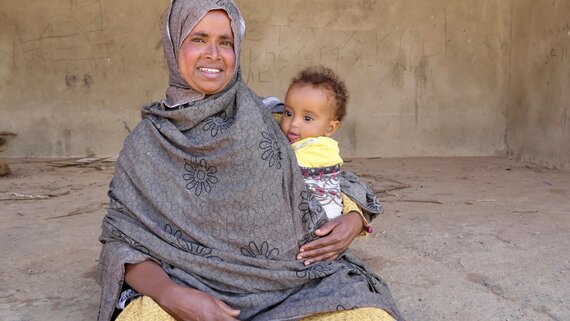
Kebribayah, Ethiopia
This woman was born in eastern Ethiopia 25 years ago to Somali parents. Violence in Somalia prompted them to seek shelter across the border. She has never stepped foot inside Somalia and never left Somali region, where her parents settled. She lives in the Kebribayah refugee camp. Established in 1991, it is Ethiopia’s oldest camp and home to 15,000 refugees, mostly Somali. For as long as she can remember, she has received food assistance from WFP. It has become a source of stability and familiarity in her life.
WFP/Edward JohnsonIn 2021, humanitarian access in Ethiopia became more complex due to insecurity related to the conflict in the north as well as in other parts of the country. Current levels of violence and armed conflict are unprecedented in Ethiopia’s recent history. They constitute a major impediment to relief operations, preventing millions of people from accessing assistance and further eroding their resilience, while at the same time increasing the need for humanitarian support.
Response priorities in 2022
The response priorities for 2022 will primarily focus on multisectoral life-saving and life-sustaining assistance, protection services and resilience-building to support at-risk and vulnerable people, particularly women, children, elderly persons and people with disabilities. People with the most acute humanitarian needs and those in the most life-threatening situations will be prioritized. They include IDPs, returnees, relocated persons, returning migrants and communities directly affected by humanitarian shocks. These population groups will be supported with essential protection and conflict-sensitive services. Given the growing levels of food insecurity due to persistent droughts coupled with the desert locust infestation, particular efforts will be made to scale up operations to address malnutrition and avert extreme hunger, and to mitigate the risk of people being forced to resort to negative coping mechanisms. The response strategy is prioritized around the convergence of geographical hotspots and the severity of need, while placing protection and affected people at the centre of the collective response.
Ethiopia HRP
The HRP prioritizes 22.3 million people living in conflict- and climate-affected woredas (districts) presenting the highest levels of severity of need. In particular, IDPs and non-displaced climate- and conflict-affected people will be targeted with urgent life-saving humanitarian assistance and protection services, with a particular focus on the most vulnerable women, girls, boys, elderly persons and persons with disabilities presenting extreme or catastrophic levels of humanitarian need. In addition, displaced and non-displaced population groups, including IDPs, returnees, relocated persons and migrants, presenting severe humanitarian needs will be targeted through multisectoral response by strengthening access to basic services, preventing further deterioration of their humanitarian status and supporting their resilience.
Madagascar
Analysis of the context, crisis and needs
Back-to-back droughts buffeted the Grand Sud of Madagascar during the 2019/2020 and 2020/2021 rainy seasons, leaving at least 1.6 million people in need of humanitarian assistance until May 2022. Following the failure of the 2019/2020 rains (and May/June 2020 harvest), some 554,000 people were projected to be severely food insecure until September 2020. The situation then dramatically worsened when a second drought, more severe than the first, struck the Grand Sud between November 2020 and January 2021. The region received less than 50 per cent of the normal rainfall, leading to the most acute drought since 1981. By January 2021, extreme drought impacted almost 69 per cent of the Grand Sud.
These consecutive droughts have severely impacted lives and livelihoods. The 2020/2021 drought coincided with the agricultural sowing period, with devastating consequences. In at least three districts, crop losses of up to 60 per cent compared with the five-year average were expected. In addition, farmers are having to contend with fall army worm, locusts and sandstorms, and a Rift Valley fever outbreak in the Atsimo-Andrefana and Atsinana region could severely affect livestock-based livelihoods in these areas, if not treated quickly.
At least 1.31 million people — 47 per cent of the Grand Sud’s population — are expected to face high levels of acute food insecurity from October to December 2021, including at least 28,000 people in Catastrophic food insecurity (IPC Phase 5). In a worst-case scenario, Ambovombe-Androy district will be at risk of famine, according to an IPC pilot analysis. This year marks the first time that people have been recorded in IPC Phase 5 since the IPC methodology was introduced in Madagascar in 2016. In the hardest-hit areas, people have been forced to resort to desperate survival measures, such as eating locusts, raw red cactus fruits or wild leaves. Global acute malnutrition rates have also risen sharply; they remain well above average despite seasonal improvements in the third quarter of 2021. The number of children admitted for treatment for severe acute malnutrition in the Grand Sud in the first quarter of 2021 was quadruple the five-year average. The situation is particularly critical in Ampanihy and Ambovombe districts.
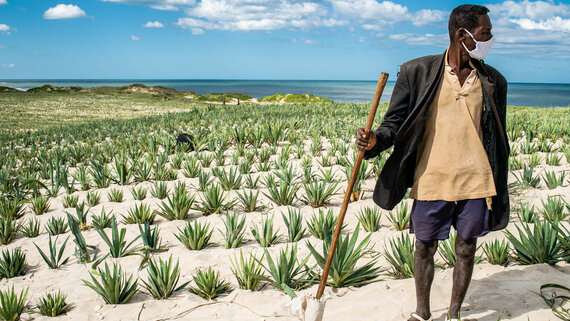
Anjampaly, Madagascar
This man is busy dune fixing. This labour provides income, protects crop fields and builds up savings. Madagascar is suffering from its most acute drought in four decades. With drought conditions persisting into 2021 and a poor harvest, weary communities have few resources to fall back on. Unexpected sandstorms have buried croplands and pastures, undermining any possibility of securing a food source. Vast swaths of arable land are now wasteland.
OCHA/Viviane RakotoarivonyThe dire humanitarian situation in the Grand Sud is leading to increasing school dropouts, a rise in gender-based violence and child abuse, and displacement from rural to urban areas in a context where access to water and basic services is extremely limited. The child marriage rate in the Grand Sud is the highest in the country; some 49 to 62 per cent of children are involved in child labour; and the risk of child exploitation and abuse has been heightened by the back-to-back droughts. Due to severe debt, people have been forced to sell all their household belongings including pots and pans, —leaving them unable to cook food or feed their families. Many families have left their rural homes and headed towards cities as a survival strategy, increasing the risk of family separation. Since the beginning of 2021, significant displacements to cities such as Ampanihy, Betroka and Taolagnaro (Fort Dauphin) have been recorded. At the same time, there has been an upsurge in criminality by dahalo gangs (cattle rustlers), particularly in the Amboasary and Taolagnaro (Fort Dauphin) districts, limiting access to essential services, such as health and nutrition. The crisis has had a severe impact on the health of communities in the Grand Sud; water shortages and water price increases of about 10 to 15 times the average are forcing families to drink and cook with unsafe water, exposing them to disease outbreaks.
Projected situation in 2022 and beyond
Humanitarian needs will remain high throughout the 2021/2022 lean season (October 2021 to May 2022) and could rise in the period ahead, with the spectre of a third failed season on the horizon. Below-average rains are expected in the first half of the October-to-December rainy season in 2021. This would severely impact the next agricultural harvest, due in May 2022. In addition, an outbreak of migratory locusts has infested more than 48,000 hectares in the Grand Sud, impacting off-season crops planted in March 2021 and the upcoming main planting season.
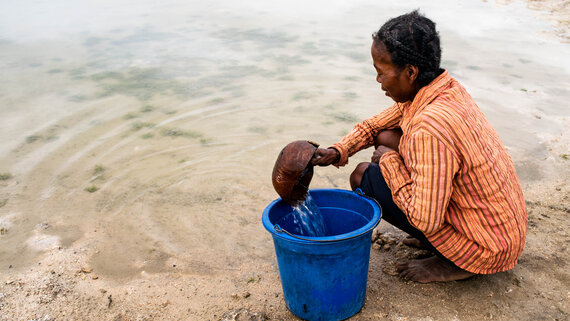
Beloha district, Madagascar
A woman collects water for her family to drink, wash and cook in the Beloha district, Androy region. Only a low number of people have access to improved drinking water sources in Madagascar’s Grand Sud, forcing most of the population to use surface water.
OCHA/Viviane RakotoarivonyWithin this context, 1.6 million people urgently need life-saving and life-sustaining assistance and protection from January to May 2022. More than 50 per cent of those in need are women and girls, who have been severely impacted by the drought. An estimated 49,500 pregnant women are exposed to excess maternal morbidity and mortality due to lack of access to essential obstetric care in the Grand Sud, while women and girls also have to travel longer distances to access water and food, exposing them to heightened risk of violence. Children are exposed to a significantly heightened risk of acute malnutrition, which could have lifelong consequences, and many have had to drop out of school to support their families during the drought.
Humanitarian partners will closely monitor the situation in the coming months, especially with respect to the prospects of the main harvest. If this harvest is below average — as with the previous two harvests — and if the locust outbreak worsens, the crisis in the Grand Sud is likely to deepen.
Response priorities in 2022
The humanitarian response in the Grand Sud significantly expanded in 2021, with the number of aid workers in the region increasing from just over 200 in January to more than 350 in August. Humanitarian partners assisted nearly 908,000 people with food, almost 410,000 people with cash transfers and 87,500 people with agricultural-revival activities. In addition, nearly 252,000 people now have improved access to clean water, and more than 52,800 children have been treated for acute malnutrition. However, while some 370,000 people in IPC Phases 4 and 5 are now receiving full rations, people in IPC Phase 3 continue to receive half rations. This is concerning in the context of a rapidly deteriorating drought.
From January to May 2022 — which coincides with the peak hunger gap period — the humanitarian response will target 1.3 million people in the most urgent need of assistance and protection in the Grand Sud. Under the Flash Appeal, multisectoral response will be geographically targeted in the nine districts facing IPC Phases 3 and 4 (Amboasary, Betroka, Ambovombe, Tsihombe, Bekily, Beloha, Ampanihy, Betioky and four communes in the Taolagnaro district). Food assistance will also be provided to people facing severe food insecurity (IPC Phase 3 and above) in Toliara II district, with the objective of saving lives and alleviating suffering in the hardest-hit areas.
Madagascar FA
The response implemented by humanitarian partners will complement and support the Government of Madagascar’s National Response Plan for the crisis in the Grand Sud, which was revised in June 2021 under the leadership of the National Office for Disaster Risk Management. The Government’s revised plan calls for US$185 million to target 1.6 million people with assistance from June 2021 to May 2022.
Logistical and physical constraints are the primary challenges to response in the Grand Sud. The Anosy region, in the eastern part of the Grand Sud, is home to most of the hard-to-reach communes. Access is particularly difficult in the Tanadava Madrere commune in the northern areas of Tolagnaro district and the Manevy commune in eastern Amboasary district due to physical access constraints and insecurity linked to banditry. There are no roads to these communes and no available airstrips; access is possible only by foot and/or canoe. An estimated 15,000 people live in these communes (10,356 in Manevy and 4,602 Tanadava Mandrere). The presence of dahalo cattle raiders has also impacted humanitarian access, although humanitarian actors and assets have not been a target of the violence to date. In 2021, violence mostly occurred in Ambovombe, Ambosary and Betroka districts, affecting people’s access to basic services and assistance, and compounding an already dire drought situation. A few communes in the northern areas of Amboasary district (Elonty, Esira, Mahabo, Mahaly, Maromby and Marotsiraka) as well as Betroka district in the northern part of Anosy have been difficult to access due to the insecurity. Road access to these areas remains possible but challenging.
Further reading
Source: Humanitarian Insight
Source: Financial Tracking Service
Source: Office for the Coordination of Humanitarian Affairs
Mozambique
Analysis of the context, crisis and needs
The conflict in northern Mozambique’s Cabo Delgado Province, which began in October 2017, continued to escalate in the first half of 2021, before intervention by foreign forces from July. The attack by non-State armed groups (NSAGs) and clashes with security in Palma District, which began in late March, forced more than 100,000 people to flee the zone by foot, boat and road to reach safer destinations. The intervention of foreign forces from Rwanda and the Southern African Development Community led to a lull in large-scale attacks. However, confrontations between NSAGs and security forces—particularly in Mocimboa da Praia, Nangade and Palma districts—displaced thousands of people, with over 6,000 people fleeing each week during operations by Mozambican and foreign forces to recapture Mocimboa da Praia in the first three weeks of August. Although there were reports of small numbers of people returning to areas recaptured by the Government and allied foreign forces in the latter half of the year, this information was difficult to verify.
Throughout 2021, the crisis in Cabo Delgado deepened the needs of displaced people — many of whom have been forced to flee multiple times — and host communities, who have continued to show incredible solidarity in the face of increasingly stretched resources and services. According to IOM’s Displacement Tracking Matrix Baseline Assessment Round 13, an estimated 745,000 people were internally displaced in northern Mozambique by September 2021, including 642,404 people in Cabo Delgado, 99,448 in Nampula and 1,221 in Niassa. Children and women accounted for 52 per cent and 27 per cent of displaced people, respectively, and there were nearly 10,800 elderly people, more than 3,800 unaccompanied children, over 3,400 pregnant women and more than 800 people with disabilities among those displaced. Around 80 per cent of displaced people were staying with family and friends in host communities, whose already meagre resources were strained tremendously by the growing influxes. Pemba City, for example, now hosts more than 152,000 displaced people on top of its original population of around 224,000 people, putting the city’s health and education services under immense pressure. In Metuge district, the number of displaced people (127,646) is higher than the original population (101,339).
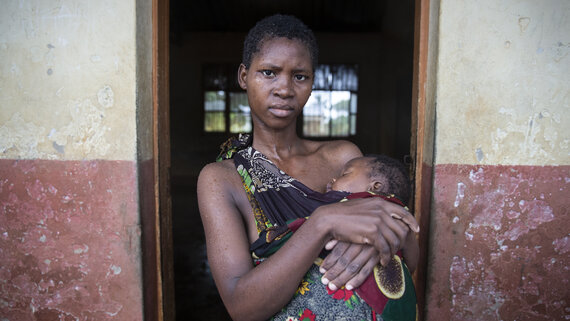
Pemba, Mozambique
This mother lost everything when Cyclone Kenneth made landfall in Cabo Delgado Province. Floods and heavy rains in northern Mozambique are exacerbating the hardship of people living there - just one year after Hurricanes Kenneth and Idai devastated the region. Violence by armed groups is also on the rise, leading to high numbers of people being displaced. In many East African countries, such as Mozambique, armed conflicts, droughts, floods and plagues of locusts are threatening the livelihoods of many families.
UNICEF/De WetProtection risks remained a grave concern, especially for women and girls, people with disabilities, older persons and people living with HIV/AIDS, with reports of horrific violence against civilians by NSAGs, including killings, beheadings and kidnappings, as well as allegations of violations by Government forces. Civilians attempting to leave Palma faced challenges and were unable to access international protection. The journey was perilous and expensive, with many people walking for days through the bush to reach safer areas. At the same time, people attempting to seek asylum in Tanzania were refouled to Mozambique, with nearly 10,400 Mozambicans forcibly returned from Tanzania to Mozambique between January and September 2021, according to UNHCR. People impacted by the conflict were exposed to gender-based violence and child abuse, and they are more likely to resort to negative coping mechanisms, including transactional sex, and be exposed to exploitation.
The armed conflict has heightened food insecurity and malnutrition, with families forced to abandon their homes and fields, and erratic rainfall in some parts of the region has compounded crop losses, according to the latest IPC analysis. In the three northern provinces — Cabo Delgado, Nampula and Niassa — more than 900,000 people are severely food insecure. In seven southern districts of Cabo Delgado, more than 228,000 people who are either displaced (128,000) or hosting displaced people (101,000) in their households were projected to face severe food insecurity (IPC Phase 3 or above) between April and September 2021. The analysis covered internally displaced people (IDPs) in five districts (Ancuabe, Balama, Chiúre, Metuge and Namuno) and households hosting IDPs in seven districts (Ancuabe, Balama, Chiúre, Metuge, Montepuez, Namuno and Pemba City) and highlighted the severe toll the crisis has taken on host communities.
The escalating violence significantly impacted essential services across Cabo Delgado. For example, in Mocimboa da Praia, widespread destruction of infrastructure — including the airport, hospital, as well as schools, and water and electrical systems — was reported in areas retaken by security forces in August. In other parts of the province, including Macomia, Muidumbe, Nangade, Palma and Quissanga, the delivery of essential services — especially health care and education — was hampered by the absence of key personnel and the destruction of or damage to facilities and equipment. Nearly half of Cabo Delgado’s health centres (43 out of 88) were forcibly closed due to insecurity. In the areas hardest hit by conflict, people were without electricity and telecommunications for most of the year. After 13 months of general blackout, electricity was re-established in Mueda in September 2021, following Muidumbe, Palma, Nangade and Mocimboa da Praia. Partial phone and internet connectivity re-established between Palma and Mocimboa da Praia.
Projected situation in 2022 and beyond
At least 1.5 million people will need life-saving and life-sustaining humanitarian assistance and protection in northern Mozambique in 2022 due to the continued impact of armed conflict, violence and insecurity in Cabo Delgado Province. This includes the 745,000 conflict-displaced people, as well as people in host communities whose coping capacities have been exhausted after three years of opening their homes to those fleeing the violence. While the Government works to combat non-state armed groups and restore peace in Cabo Delgado—with support from the international community and allied forces—some returns of people to areas recaptured are anticipated in 2022. The situation, however, remains volatile and attacks by NSAGs as well as allegations of violations against civilian by security forces continue to be reported. In addition, the conflict and repeated displacement have destroyed livelihoods, disrupted markets, and essential services across the hardest-hit districts, particularly affecting access to education and health services in a region facing endemic disease outbreaks. Therefore, the Protection Cluster continues to emphasize the importance of returns taking place only when security conditions are met and services are restored in line with accepted standards.
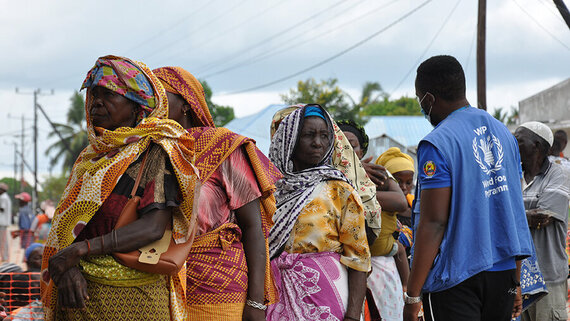
Beira, Mozambique
Escalating violence in northern Mozambique is pushing hundreds of thousands of people into food insecurity. "They sit in cramped areas with no shelter, no sanitation, struggling to process the trauma of horrors they’ve experienced," said WFP’s Regional Director for Southern Africa. Climatic shocks, which disrupted agriculture, fisheries and livelihoods, are compounding problems: only limited supplies are reaching markets, which means the cost of food and household items is rising fast.
WFP/Sean RajmanHumanitarian needs are concentrated in the districts hardest hit by the conflict — Macomia, Mocimboa da Praia, Palma and Quissanga — as well as those that host the highest number of displaced people, namely Nangade, Metuge, Montepuez, Mueda and Pemba. The unique needs of women and girls are a high priority, with 53 per cent of people in need being female and women-headed households — who constitute one third of families in the three northern provinces — who are faced with specific challenges. The crisis has severely impacted children, with some 59 per cent of people across Cabo Delgado, Nampula and Niassa being under 19 years old, according to the census. While only 3 per cent of people in Cabo Delgado, Nampula and Niassa are over 65 years old, they face multiple unique challenges, including difficulties fleeing conflict as well as constraints on physical access to services. Ensuring access to vital services and holistic support for the estimated 468,000 people (most of whom are women) living with HIV in Cabo Delgado, Nampula and Niassa is critical.
Response priorities in 2022
Humanitarian organizations significantly scaled up their response in northern Mozambique in 2021, enabling partners to provide life-saving and life-sustaining assistance and protection to 1.23 million people; more than double the number of people reached in 2020 (515,000). More than 957,300 people—52 per cent of them women—received regular food assistance, although underfunding has forced humanitarians to distribute half rations since August. By the end of August, more than 850 aid workers—more than 730 of them Mozambican— were delivering assistance and protection across Cabo Delgado Province (up from just over 300 in October 2020), and by the end of September at least 66 humanitarian organizations were responding (up from 47 in January 2021), of which 58 per cent (38) were international non-governmental organizations (INGOs), 30 per cent (20) national NGOs and 12 per cent (8) UN entities.
A key focus in 2021 was expanding the scale and scope of humanitarian operations in hard-to-reach and partially accessible areas. This was done through a combination of inter-agency rapid assessment and response missions, as well as establishing district-level coordination and response, leveraging the capacity of partners based in the districts in Ancuabe, Balama, Chiure, Ibo, Macomia, Mueda and Namuno. However, humanitarian movements remained constrained in some areas due to insecurity and administrative obstacles. People’s access to essential services—especially health and education—remained inadequate in many parts of Cabo Delgado due destruction, damage and absence of personnel.
Mozambique HRP
In 2022, the humanitarian response in northern Mozambique will target 1.2 million people in the most urgent need of assistance and protection in Cabo Delgado, Nampula and Niassa. The geographic focus of the response is aligned with the severity of the needs identified, with an emphasis on districts that host the highest numbers of displaced people and districts hardest hit by the conflict.
Humanitarian actors will coordinate closely with development actors, who will be working to rebuild infrastructure and re-establish essential services impacted by the conflict in 2022. It will include identifying complementarities with the activities promoted by the Government’s Agency for Integrated Development of the North (ADIN). The Agency, with support from the international community, is working with the UN, local authorities, non-governmental organizations, and other local stakeholders to build or rehabilitate public and private services, such as public administration buildings, health and education facilities, access roads, energy and telecommunication systems, water supplies, markets and shops.
Further reading
Source: OCHA
Source: Humanitarian Insight
Source: Financial Tracking Service
Somalia
Analysis of the context, crisis and needs
Despite progress in recent years, conflict, recurrent climate shocks, disease outbreaks, large-scale evictions and increasing poverty are devastating the people of Somalia. An estimated 7.7 million people will require humanitarian assistance and protection in 2022, and women and children continue to bear the brunt of the crisis.
Throughout 2021, the country saw heightened political tensions in the context of a delayed electoral process, as well as a continued military offensive against Al-Shabaab in central and southern areas. The resulting conflict and insecurity were the main drivers of displacement, forcing 420,000 people to flee their homes by October. An estimated 2.9 million people are internally displaced throughout the country. Most of these people live in informal sites, often facing the danger of eviction by landowners. Women and girls make up half of the displaced population and face a heightened risk of sexual violence and harassment, abuse and intimate partner violence.
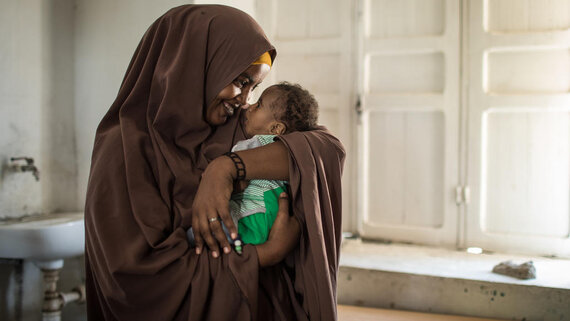
Somalia
This mother's baby was born a month early and had to stay in an incubator for 33 days. The 10-month-old suffered from medical complications and remained underweight. She received treatment at an IRC-run nutrition clinic and then moved to a local stabilization centre for one week. She continues to receive care at the clinic. “She has made huge progress,” said her mother. “When I first brought her, you could easily count her ribs.” She now weighs 8 lbs and is growing.
IRC/Kellie RyanSomalia remains on the front line of climate change. It is currently experiencing its third consecutive season of below-average rainfall, with central and southern areas enduring moderate-to-severe drought conditions, water shortages and livestock deaths. One in every five people does not have enough water to cover their basic needs. Critically, climate change is increasingly understood as a major driver of conflict and rapid urbanization. COVID-19 and desert locusts continue to pose a threat.
The combined impact of these recurring stress factors has deepened and widened poverty, with an estimated 71 per cent of the population living below the poverty line, particularly in rural areas and areas where access remains a challenge. Somalia also continues to exhibit some of the highest infant, child and maternal mortality rates in the world.
Projected situation in 2022 and beyond
With available climate forecasts indicating below-average rainfall in November, it is becoming increasingly likely that a major and worsening drought is unfolding in Somalia. Long-range forecasts for the 2022 Gu rains suggest elevated chances of a fourth below-average rainfall season. Somalia last experienced a four-season drought in 2016/2017, when sustained and early action by the Government and the international community helped avert the worst outcomes.
At the same time, large parts of the country remain prone to severe riverine and flash flooding. Based on a trend analysis of recent years, it is estimated that up to 450,000 additional people will be displaced by floods and up to 96,200 people by droughts in 2022. Conflict and insecurity are also likely to remain a major driver of humanitarian needs and displacement next year. In addition to ongoing political tensions and conflict with Al-Shabaab, the reconfiguration of AMISOM and closure of Forward Operating Bases are likely to leave a security vacuum, which may lead to displacement and impede humanitarian access. Overall, it is expected that up to 280,000 additional civilians will be displaced due to conflict in 2022.
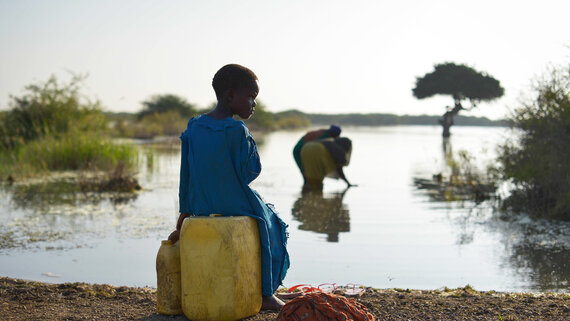
Jowhar, Somalia
A young girl sits on a jerry can as her mother fills another with water, near the town of Jowhar. The surrounding area experienced significant flooding, which blocked off the town from main roads. Thousands were forced to flee their homes and seek shelter on higher ground.
UN/Tobin JonesWithout humanitarian assistance, nearly 3.5 million people across Somalia are expected to face acute food insecurity at crisis (IPC Phase 3) or worse levels through the end of 2021. In 2022, some 1.2 million children under 5 years of age are likely to be acutely malnourished, nearly 300,000 of whom are projected to be severely malnourished and may be at risk of dying without immediate treatment. Severe drought conditions are expected to cause water to become scarce and pathogens to accumulate in stagnant water. People and cattle will be pushed to use contaminated water, sharply increasing the risk of a cholera/acute watery diarrhoea outbreak. This will also increase women’s and girls’ exposure to the risk of sexual and gender-based violence due to walking longer distances to access water.
Response priorities in 2022
Despite operational and access challenges, humanitarian partners reached some 3 million people (77 per cent of those targeted) with humanitarian assistance in 2021. In 2022, spikes in health, WASH and shelter needs – as well as updated baseline population estimates – have led to an increase in the number of people in need and targeted. The 2022 Humanitarian Response Plan will aim to respond to the most immediate needs of 5.5 million people. The top priority is to provide life-saving assistance for 5 million of the most severely vulnerable people, including 1 million children under 5 years of age, by decreasing the prevalence of hunger, acute malnutrition, public health threats and outbreaks, abuse, violence and exposure to explosive ordnance. In addition, partners will work to sustain the lives of 5.5 million people requiring humanitarian assistance by ensuring safe, equitable and dignified access to livelihoods and essential services.
Somalia HRP
Finally, the Somali response aims to uphold commitments to the centrality of protection across the humanitarian response through protection mainstreaming, accountability to affected populations and monitoring of the protection environment. Cross-cutting vulnerable groups will be taken into consideration, including a renewed focus on people with minority clan affiliation, marginalized groups, and those residing in rural areas or areas with high access constraints.
Achievements and innovations
The Joint Analysis Process was modified and strengthened for the Somalia Humanitarian Needs Overview (HNO) 2022 with the implementation of a sequenced and thematic joint analysis process that involved over 20 different primary data sources, as well as a broad range of secondary data. All analysis was conducted in line with processes and categories outlined by the global Joint Intersectoral Analysis Framework (JIAF). To ensure more targeted and intersectoral analyses, data providers (e.g. FSNAU, REACH, IOM DTM, UNHCR PRMN, WFP mVAM and others) were mapped out and categorized as providing data on a number of themes – impact on people, impact on services, access, accountability to affected populations, cash and markets, and inclusion. These themes were based partly on the JIAF sub-pillars and partly on relevant cross-cutting topics.
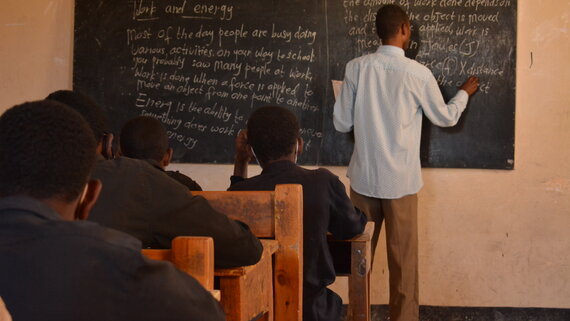
Sanaag region, Somalia
A teacher writes on a blackboard in front of his class. School education is a major challenge in Sanaag region. Most children are from pastoralist families and do not have access to education. In Ceerigabo town, NGO partner Candlelight for Environment set up a primary and secondary school in August 2006, for pupils age 5 to 15. In 2021, it enrolled 110 girls and 109 boys. The students pay a school fee, but those who cannot pay and families who have many children receive free education.
Candlelight/Abdinasir AhmedData providers then provided a preliminary analysis of their own data sets for each relevant theme, which was then triangulated and combined into joint analysis per theme by technical specialists and relevant cluster leads. A collaboration with the GIMAC DEEP Platform ensured the integration of secondary data sources throughout this process. The resulting intersectoral thematic analyses were presented at the Humanitarian Programme Cycle 2022 Deep Dive Analysis Workshop for Inter-Cluster Coordination Group endorsement, and provided the analytical framework for the HNO report.
Further reading
Source: OCHA
Source: Humanitarian Insight
Source: Financial Tracking Service
South Sudan
Analysis of the context, crisis and needs
People in South Sudan continue to face the multiple compounding shocks of continued food insecurity, macroeconomic shocks, three consecutive years of flooding, disease outbreaks, increased sub-national violence, and threats and attacks on humanitarian workers and assets, resulting in an overall protection crisis. Implementation of the 2018 Revitalized Agreement on the Resolution of the Conflict in the Republic of South Sudan continues, albeit at a slow pace. Key benchmarks for the transition achieved in 2021 include the appointment of governors for all 10 states and the appointment of legislators for the national parliament. The remaining pre-transitional tasks include the critical formation and graduation of unified forces. The country has embarked on a constitution-making process, and democratic elections are slated to take place in 2023.
South Sudan is facing its highest levels of food insecurity and malnutrition since the country declared independence ten years ago. The Integrated Phase Classification (IPC) report released in December 2020 projected that an estimated 7.24 million people would face acute food insecurity from April to July 2021. Of these people, 108,000 were projected to be in IPC 5, 2.4 million in IPC 4 and 4.6 million in IPC 3. An estimated 1.4 million children under 5 years of age, the highest number since 2013, were expected to be acutely malnourished in 2021.
As of 19 November, an estimated 809,000 people were reported as affected by floods in 33 counties in eight states since May 2021. Jonglei, Unity and Upper Nile states are the worst affected. These three states account for more than 75 per cent of the total number of people affected. People’s livelihoods are being erroded as their livestock are decimated, homes, schools and crops are submerged. Flood-displaced people now sheltering in poor conditions are at risk of exposure to waterborne diseases. Some 100,000 people, mainly from Twic East, who were displaced by the 2020 floods, have not yet returned home as their lands remain underwater. Over two thirds of flood-affected counties were projected to face high levels of acute food insecurity this year, thereby exacerbating the dire humanitarian conditions of an already vulnerable people.
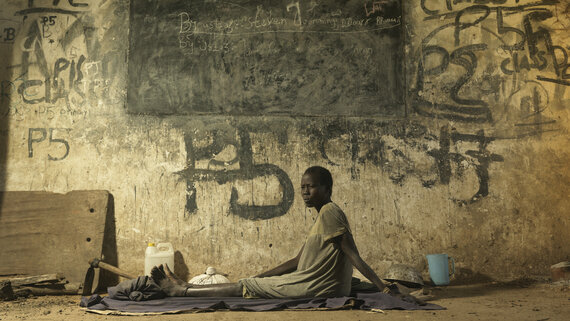
Old Fangak, South Sudan
A pregnant woman sleeps on the floor of a classroom in Old Fangak. Unrelenting floods from weeks of heavy rains swept away homes and inundated farmlands. Families and livestock have been forced to seek safety on higher ground and in neighbouring towns. The effects of the climate emergency are profoundly felt in East Africa. Communities, already struggling, are facing unprecedented floods and storms, unreliable rainfall, and the distress of hotter and drier conditions, as their basic needs and rights to water, food, livelihoods, land and a healthy environment are hit hard.
Action Against Hunger/Peter CatonThe Bentiu camp for internally displaced persons (IDPs) hosts some 108,000 displaced people. An alarming rise in Hepatitis E (HEV) prevalence and cases of acute watery diarrhoea was driven by a deteriorating water, sanitation and hygiene situation. As of 10 October 2021, a cumulative 1,309 HEV cases, including nine deaths, have been reported since 2019. HEV cases in the camp have risen to over 113 per cent from 2019 to 2020, and by 225 per cent from 2020 to date.
According to the WASH Severity Classification analysis (December 2020 – May 2021), WASH conditions in 51 of 78 counties were classified as phase 4, and 3 were classified as phase 5. The results of this analysis will likely drive an immediate response scale-up to address WASH needs.
Physical insecurity, bureaucratic impediments and threats against humanitarian workers and assets have increased in various counties. From January to September 2021, 415 access incidents were reported. Insecurity forced the relocation of 80 aid workers from Ayod and New Fangak counties in Jonglei State, Nagero and Tambura in Western Equatoria State, and the Greater Pibor Administrative Area. Aggressive and sometimes violent demands by youth for employment opportunities disrupted humanitarian operations in Torit, Renk, Koch, Ulang, Kapoeta, Jamjang, Gumuruk and Bentiu. During this period, four aid workers were killed in the line of duty and more than 200 aid workers were relocated from their areas of operation due to security threats. Between 8 July and 21 August, 312 metric tons of critical food items were looted in several parts of the country, affecting humanitarians’ ability to respond efficiently to people in need.
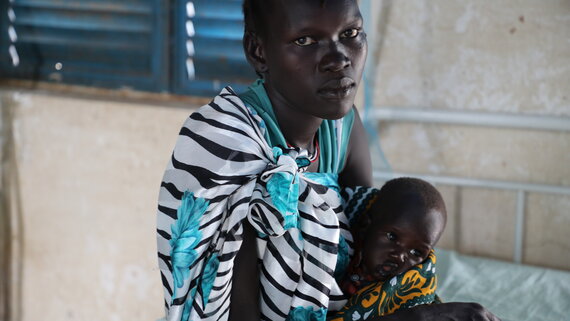
Pibor, South Sudan
A mother with her child at a stabilization centre for malnourished children in Pibor town, Greater Pibor Administrative Area.
OCHA/Htet Htet OoRepeated episodes of sub-national violence, such as in Tambura County in Western Equatoria State since June 2021, displaced an estimated 80,000 people. Killings of civilians, including men, women and children, abductions and conflict-related sexual violence allegedly perpetrated by armed men were reported, including forced recruitment in Tambura/Ezo targeting men and boys. Multiple testimonies from a protection report reflected high levels of violence included the targeting of civilians based on ethnicity and gender. Initial reports indicate that at least 200 people were killed. Witnesses and survivors report the rape of young women and girls by men in uniforms and civilian clothing with family members forced to witness.
Some 4 million South Sudanese people remain displaced due to conflict, insecurity and weather shocks. An estimated 1.7 million people are internally displaced and an additional 2.3 million South Sudanese are refugees in neighbouring countries. In addition, 91,000 South Sudanese refugees returned, predominantly from Sudan and Uganda, from January to end of September 2021.
Returns are also taking place in remote locations where there is limited infrastructure and access, an absence of housing, land and property, and protection risks that challenge peaceful coexistence with host communities.
Projected situation in 2022 and beyond
A continued deterioration of the humanitarian situation is expected, as needs are likely to increase. Factors likely to contribute to this include climate change and a forecast for continued rains into 2022, resulting in further flooding and more displacement. In addition, the country’s weak health system, low water supply coverage, poor hygiene and sanitation services, sub-national violence, reduced access as well as the limited humanitarian assistance footprint will continue to threaten an already vulnerable people.
WASH conditions are expected to worsen in 56 counties, remain the same in 14 counties, and improve in two counties. The forecast is primarily based on expected flood damage to existing WASH infrastructure during the wet season and the resulting increase in open-defecation practices, use of surface water for drinking, risk of disease outbreaks, and reduced humanitarian access for WASH actors due to insecurity and flooding.

Juba, South Sudan
Community focal points attend a training on gender-based violence (GBV) at the Women’s Union. GBV is one of the most critical threats to the protection and well-being of women and children in South Sudan. Many women and girls have experienced non-partner sexual violence, primarily during attacks or raids. The risk of child marriage remains constant due to conflict and the country’s economic situation.
UNICEF/Albert Gonzalez FarranSouth Sudanese women and girls are likely to face extreme levels of gender-based violence, exacerbated by armed conflict, organized violence and forced displacement due to flooding. Much of the violence goes underreported, with limited response services available to survivors. This creates conditions for conflict-related sexual violence and barriers for survivors to access gender-based violence response services due to ongoing violence in Tambura County.
Driven by a decline in oil and non-oil sectors and several concurrent shocks, including COVID-19, South Sudan’s GDP is expected to contract by 4 per cent in 2021.
Response priorities in 2022
The two-year 2022-2023 Humanitarian Response Plan (HRP) will be guided by three overarching strategic objectives addressing the three humanitarian conditions: physical and mental well-being, living standards and coping mechanisms. The multi-year plan will capitalize on the humanitarian-development-peace nexus efforts in the country and integrate disaster reduction and mitigation measures within programming. Humanitarian and protection needs, especially for women and children, continued to grow in South Sudan in 2021 and are expected to continue in 2022 as a result of recurring conflict and subsequent displacement, a climate emergency, an inability to reach health care and lack of access to schools.
Humanitarian organizations reached some 4.8 million people with humanitarian assistance and protection services by the end of September 2021. Key achievements include over 4.1 million people who received food assistance and livelihoods support; over 1.3 million people reached with healthcare; approximately 1 million people assisted with protection services; and some 1 million people provided access to safe water and sanitation. Over 930,000 children, pregnant and breastfeeding women were provided with emergency nutritional assistance; about 832,000 people received essential household items and emergency shelter. Some 720,000 people were reached through camp coordination and camp management services; and over 189,000 children were supported with access to education in emergencies.
South Sudan HRP
Humanitarian access challenges include operational interference, bureaucratic impediments, threats and violence against humanitarian personnel and assets and physical challenges caused by flooding. These challenges hampered humanitarian response to vulnerable people across the country. This year, Jonglei, Central and Western Equatoria experienced an upsurge in violence, affecting the delivery of humanitarian assistance to conflict- and flood-affected people. Humanitarian organizations reached half of their target population in these locations by the end of September. In Warrap State, where people were projected to face record levels of food insecurity during the lean season of May-July 2021, humanitarian organizations faced challenges to reach vulnerable people due to insecurity. Similarly, insecurity hampered the delivery of humanitarian assistance and services to the conflict-affected people in Tambura of Western Equatoria State, where some 80,000 people were displaced by conflict since June.
Since March, there has been a rise in the number of attacks against aid workers, people serving the community, and assets across South Sudan. Humanitarian warehouses and facilities were targeted during violence with humanitarian supplies looted, significantly impacting response operations in conflict-affected and food-insecure areas. Operational interference and threats by youth groups across the country have remained a challenge, leading to suspension of humanitarian activities, and increasing people’s vulnerability. Throughout 2021, youth groups continued to demand exclusive local employment with humanitarian organisation, and often shows aggressive, threatening stances to voice their demands. This behaviour led to the suspension of humanitarian activities and the relocation of workers from some locations. Negotiations between youth, local authorities, community leaders and the humanitarian community are ongoing to find a resolution. Between January and September 2021, more than 200 aid workers were relocated due to security threats.
As of 12 November, the 2021 South Sudan HRP was 64 per cent funded. Despite the relatively good funding received, humanitarian needs continue to grow, outstripping the available funding to respond in an effective and timely manner.
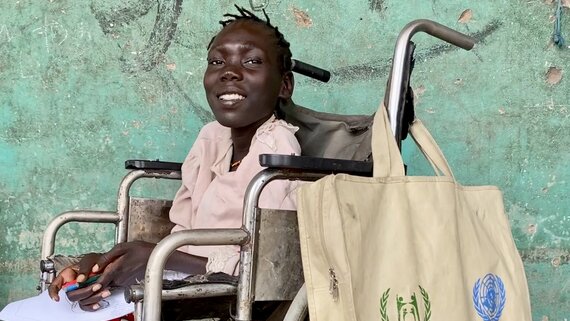
Pibor, South Sudan
This 13-year-old girl is determined to go to school despite the persistent violence and recurrent flooding. With funding from the South Sudan Humanitarian Fund, she has received psychosocial and other support.
OCHA/Emmi AntinojaAchievements and innovations
In the context of South Sudan, Accountability to affected populations (AAP) remains of paramount importance to the overall humanitarian response, propelled by the operational responsibilities to promote a rights-based approach and improve aid effectiveness across humanitarian programming. Recent demands and grievances expressed by youth led to significant interference in humanitarian operations in several locations. For those with legitimate concerns, investment has increased in AAP and engagement strategies with the community, including youth representatives, to hear their concerns, respond appropriately and sensitize about how humanitarian activities take place.
In 2021, cluster coordinators engaged in a strategic AAP workshop to review and seek opportunities to strengthen community engagement and participation, with the aim of ensuring that affected populations are at the centre of humanitarian action. The workshop outcomes informed the development of a Humanitarian Country Team (HCT) AAP strategy intended to solidify the HCT’s role when leading on AAP across the response. The HCT AAP strategy complements the Centrality of Protection and Gender in Equality Programming in Emergencies road maps. The HCT AAP strategy supports the operationalization of the Inter-Agency Standing Committee’s commitments on AAP and the prevention of sexual exploitation and abuse at the response level. It is guided by five strategic objectives:
- Oversight of senior leadership on key AAP issues.
- AAP is mainstreamed throughout the Humanitarian Programme Cycle to enable a community-centred response.
- Ensure decentralized leadership on AAP to State-level coordination mechanisms empowered to ensure AAP strategies are informed by local contexts.
- Collective mechanisms are developed at the response level for a coordinated approach to AAP
- Enhance the communications and community engagement and AAP capacity of national organizations and civil-society actors as well as their role within humanitarian decision-making.
Further reading
Source: OCHA
Source: Humanitarian Insight
Source: Financial Tracking Service
Sudan
Analysis of the context, crisis and needs
During the second year of transition, the Government of Sudan continued its efforts to establish peace in the country, reforming the economy, working towards macroeconomic stability, and supporting the needs of the most vulnerable people. On 9 June, the government lifted fuel subsidies and completely liberalised fuel prices. This led to a fifty-fold increase in the price of petrol (the subsidized price of petrol was 6.17 SDG and the price after the lifting of the subsidies was 320 SDG). Following these reforms, the exchange rate and the inflation rate were expected to stabilize starting from 2022 and remain moderate for the coming years. On 28 June, the IMF Executive Board announced that Sudan had reached the decision point for the Highly Indebted Poor Countries initiative. Following commitments made by Member States in Paris on 29 June, the IMF and the World Bank approved initial debt relief for Sudan, reducing the country’s debt from US$56 billion to $28 billion. However, it will take time before the country sees the positive impact of these changes including that of economic reforms.
While the military coup d’état of 25 October 2021 had a limited immediate consequence in humanitarian operations, the pause of development assistance could influence basic social services and programmes supporting people’s ability to bear the impact of economic reforms.
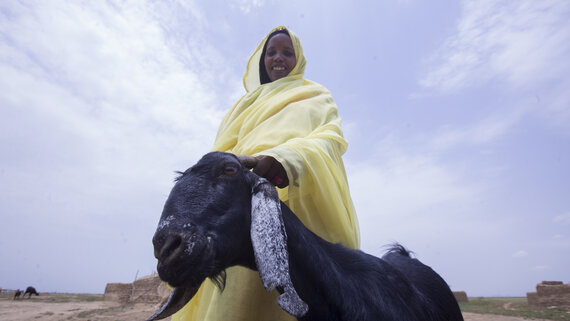
Kassala, Sudan
An early warning system predicted a drought in Kassala, Sudan. Animal health treatments and feed mitigate the impacts of the drought and enable farmers to protect their livelihoods and food security. Sudan has long been known as one of Africa’s most arid countries, but rainfall in recent years has become even more erratic. Extreme events, such as drought, are becoming more common. Seventy per cent of rural people in Sudan rely on rain-fed agriculture and livestock-rearing, but the unpredictable and intense conditions, such as those in Kassala, are stretching their coping capacities to the limit. The cumulative effects of this "new normal" are taking a toll; one drought can follow another, each time stripping away hard-earned but limited resources.
FAO/Ahmedalidreesy AbdilContinuing economic crisis, including high inflation, resulted in elevated levels of food insecurity, while hundreds of thousands of displaced people in Darfur and other parts of the country remain in protracted displacement needing specific assistance including protection. Over the past year, parts of the country – including in Darfur and South Kordofan – witnessed increased insecurity and localized violence. Since the beginning of the year, over 365,000 people were displaced, many of whom were already displaced as a result of the crisis in Darfur in 2003-2004, and in South Kordofan in 2011 and onwards. Flooding and concurrent disease outbreaks are straining the limited ability of state institutions to provide basic services. Despite these challenges, the country hosts about 1.2 million refugees and asylum seekers, making Sudan one of the top 10 refugee-hosting countries.
In 2021, heavy rains and floods affected about 314,000 people. An increase in waterborne and vector borne diseases, including watery diarrhoea, typhoid, malaria and dengue fever, is foreseen in the coming months. During the first nine months of 2021, about 1.6 million cases of malaria were reported across Sudan, while about 2.2 million cases were recorded in 2020. Since the end of August, the national health authorities have reported three concurrent disease outbreaks following the rainy season. Specifically, multiple cases of Hepatitis E, dengue fever and measles were registered in different country states, further exacerbating an already precarious health system.
Projected situation in 2022 and beyond
About 14.3 million people –almost one in every three people–- across the country are projected to need some sort of humanitarian assistance in 2022. Close to 64 per cent of those 9.1 million people in need will require emergency assistance for life-threatening needs related to critical physical and mental well-being. This is quarter increase compared to the previous year, highlighting the enormous hardship that many people face. Meanwhile, 14 million people –- or 98 per cent of those in need – require life-sustaining support to meet minimum living standards. These figures indicate an increase in needs and a worsening of the severity of needs. The highest needs include water and sanitation, food security and health. Approximately 8 million people in need are women and girls. Particularly vulnerable groups include 2.9 million displaced people and 1.2 million refugees. Khartoum, North Darfur and South Darfur states account for most of the increase in the number of people in need. Meanwhile, it is estimated that it will take time to find and implement durable solutions for internally displaced persons (IDPs), both protracted IDPs and newly displaced people, as well as the 1.1 million refugees.
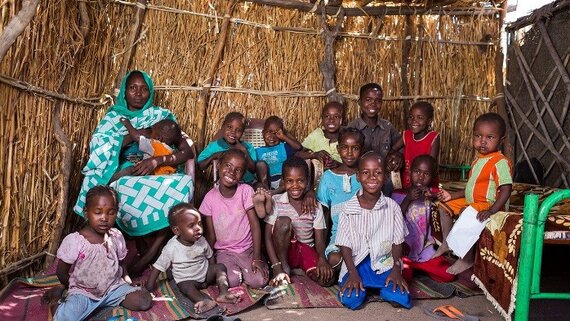
Kalma, Sudan
This displaced mother of five lives in Kalma camp, South Darfur. Her two youngest children suffer from malnutrition and are benefitting from nutrition activities. Through WFP’s cash and food vouchers, the family also receives monthly food assistance that includes sorghum, oil and salt. She explains: “My family and I fled our home, leaving behind everything we owned, to seek safety away from the terror brought by war. We came to this camp we now call home with nothing but the clothes we were wearing. My husband was very ill and was not doing well. A year from our drastic life transformation, he passed away. He gave me these three beautiful kids before his passing, and I am very grateful. But life as a single woman is tough, so I re-married here in the camp five years ago and gave birth to two more children. Their father is away for work and does not come back often. He tries his best to support us financially, but it is not enough. So, I work as a Tea Lady in the market, while my eldest son helps by picking mangoes and selling them in the market. We don’t make much, but we manage to get by."
WFP/Alaa KeirThe humanitarian situation in Sudan is compounded by deep-rooted poverty and an economic crisis. The country faces several overlapping challenges, including internal population displacement triggered by conflict, and climatic and socio-cultural conditions leading to high levels of food insecurity and malnutrition. However, the economy is the main driver of people in need. For the Humanitarian Needs Overview (HNO) 2022, the drivers of need have been broken down into five main categories: the economy, localized conflict and protracted displacement, natural hazards, disease outbreaks and food insecurity.
According to the International Monetary Fund, the economy in Sudan has been in recession since 2018, with a projected economic growth for 2021 of 0.9 per cent. The near-term economic growth, the key to tackling the economic crisis, will continue to be subdued owing to low consumption and investment owing to factors such as high inflation and unemployment. In 2022, the economic growth is expected to be 3.5 per cent. However, these growth rates are not sufficient in the immediate term to drastically reduce food insecurity levels and other vulnerabilities induced by the economic crisis. It is also estimated that more than 350,000 people are likely to be affected by heavy rains and flooding across Sudan in 2022, with many needing shelter, water, sanitation and other support.
Response priorities in 2022
Humanitarian organizations scaled up assistance in 2021 despite operational challenges posed by COVID-19, the economic crisis and the October 2021 coup d’état. Improvements in humanitarian access under the transitional civilian government have continued, and sustained humanitarian access has been witnessed in areas under non–State armed groups' control.
In 2021, operations continued to grow in response to an increment of humanitarian needs driven by unaddressed root causes of the crisis and underlying factors. By June 2021, humanitarians reached more than 7 million people with some form of assistance. In 2022, US$1.9 billion is required to support the humanitarian response. The funding requirements are backed up by detailed activity-costing with targets at the locality (second administrative level).
Sudan HRP
In 2022, the Humanitarian Response Plan (HRP) will ensure an inclusive and dignified humanitarian response to the most vulnerable people within Sudan. The response will prioritize life-saving multisectoral assistance in areas with the highest convergence of severity of needs, including response readiness for recurring flooding, conflict and disease outbreaks. Partners will scale up food assistance, disease prevention and response, and emergency response to those newly displaced by conflict or flooding. The response will also prioritize life-sustaining services, such as essential health services, surveillance of and response to waterborne and vector borne diseases, education, livelihood opportunities, water and sanitation, supplemental nutrition and school feeding. Finally, the HRP will prioritize the mitigation of and response to protection needs. Where possible, the humanitarian aid delivery will also aim to build community capacity, sustain durable solutions and promote social peace.
Achievements and innovations
The 2022 HNO and HRP were developed using evidence-based primary and secondary data sources, such as a vulnerability assessment focused on refugees (BANVA), Displacement Tracking and Monitoring, in-depth secondary data review using the Data Entry and Exploration Platform (DEEP), the IPC and a Multi-Sectoral Needs Assessment (MSNA). The 2021 MSNA survey for Sudan overcame most of the challenges faced during the previous year, significantly reducing the phone-based data collection and increasing the geographical coverage. A total of 19,000 households were reached during the survey, a third more than in 2020, with 76 per cent of the survey (14,405 households) using a face-to-face approach despite COVID-19-related challenges.
Additionally, DEEP was introduced in Sudan for the first time, producing a first-level analysis of secondary data available, including key findings aligned with the Joint Intersectoral Analysis Framework. DEEP analysed 162 reports from 2021, cataloguing 7,212 unique data points. The secondary analysis document comprises 10 sections covering everything from the context and humanitarian access to the impact of COVID-19 and priority of needs.
Further reading
Source: OCHA
Source: Humanitarian Insight
Source: Financial Tracking Service
References
- The People in Need figure is indicative. The final figures will be reflected in the final HNO and HRP, and in subsequent GHO updates.
- Ibid.
- South Sudan, IPC Acute Food Insecurity & Acute Malnutrition Analysis, 18 December 2020.
- OCHA South Sudan Humanitarian Snapshot, September 2021.
- South Sudan - Humanitarian Snapshot, March 2021
- South Sudan, Displacement Tracking Matrix, Quarter 2 Report, 2021. *The final validation of the multisectoral needs in sites and villages/neighbourhoods was in process as of the end of this reporting period and would cover more than 2,500 locations.

